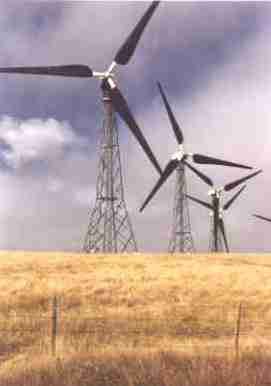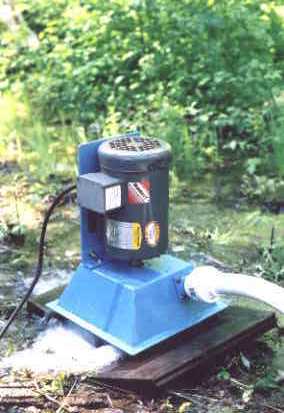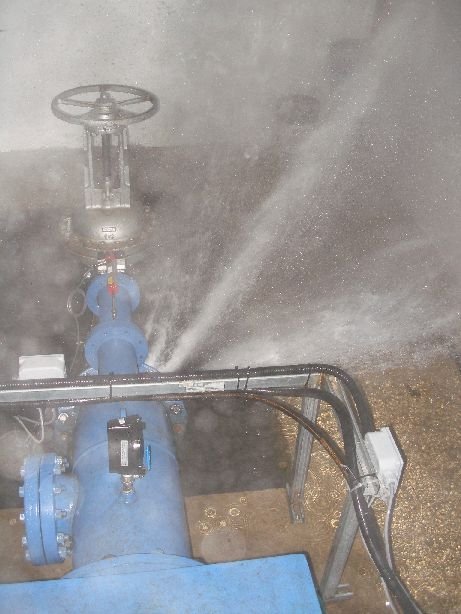Electricity from the Sun, Wind and Water
|
|
Return links: Return to Home Page DC Hydro Systems AC Hydro Systems Solar Equipment Basic Electricity Formulas & Tables Communications >FAQ & Answers Equipment sales Contact and Forms |
|
|
Frequently Asked Questions: Hydro or Solar, which is best for me? You either have access to flowing water or you don't. If you do, hydro is without doubt the way to go. There is far more energy available in a mass of water falling some height than in 'the soft rain of photons' striking silicon. Even if the water source is half a mile away, it may be less expensive to string a long power line than invest in solar modules. Hydro will produce 24H / 365D, and when the demand is greatest, typically in winter, the water source will generally be high. If your situation is more typical, you will not have access to flowing water. However, the sun does (occasionally) shine on all of us. There are thousands of modules supplying electricity to remote sites in BC. Unfortunately, the climate in BC, especially at the coast, is not always conducive for high output. It would take a large array of photo-voltaic modules to come close to supplying the energy obtainable from even a modest hydro plant. You really need to do an analysis of your loads, and determine the solar influx available at your site to see if it is practical to proceed with a home sized system. For stand alone telemetry sites, data logging or other low current demands, solar will win hands down. What is the life span of the generating equipment?Solar panels are rated as retaining 90% of their output for 25 years or more. Since there are no moving parts, a well installed system will have a life span which far exceeds the current level of technology. Turbines are fitted with bearings which are replaceable. Stream Engines will run for several years continually under heavy load before the bearings may need attention. They are an inexpensive automotive type, and can be replaced easily. There are no brushes in these units, and nothing else to replace. Old auto alternators require brush replacement on a more frequent schedule. This depends on the load and rpm the machine is operating at. They should be checked monthly, as every system is unique. Six months to two years is an approximate range. The life span of larger AC hydro plants is measured in decades with very little maintenance. There is no reason they can not be kept operational indefinitely, with periodic bearing replacement. What is the life span of inverters and control equipment? I have not yet seen any of this equipment fail in normal use. Modern electronics is so reliable that unless there is an external fault or a lightning strike, there is no reason the equipment can't me kept in service for many years. That is not to say there can never be a failure. It is important to correctly fuse all current carrying wires, and in some situations, you may want to carry some spare components. What is the noise level of a hydro plant? The small 'Stream Engines' pictured here are extremely quiet. There is a soft whirring heard when standing next to the units, but in the house, or standing away from the unit, the sound is barely if at all noticeable. Noise can be virtually eliminated by careful mounting on non resonating surfaces, then enclosing in an insulated box. The tail race, or the water that has passed thru the turbine, will flow directly back to the creek. This is either discharged under water or the pipe end covered with rocks to dampen any sound carried thru the pipe. How should the building be wired? If you are planning new construction and anticipate having an AC home power system, you should wire the cabin as you would for a grid tied home. If using one inverter, you will likely be producing 120 volts. Most distribution panels are designed for 120 / 240 volt use. It is important to wire the circuits so that at no time can a neutral conductor carry more than its rated current. Problems could occur if you had two hot wires and one neutral feeding a kitchen outlet in a so called 'Edison Circuit' where normally that output would be fed with a three wire circuit from a 120 / 240 volt source typical to most grid connected homes. Use the provincial standards, and return all circuits to a main distribution panel. Keep in mind the inverter capacity you might use, usually from 1500 watts to 5000 watts. It doesn't hurt to have many circuits, but the main breaker must be sized to match the inverter used. Obviously you can't have all the loads possible turned on at once if you only have a 1500 watt inverter. Here is where you must practice 'load management' manually. In all cases, you should have a copy of the electrical code handy, and follow all the rules for your area. Don't forget the system grounding and ground rod, this is mandatory. For DC only systems, wiring must be sized to keep voltage drops to a practical level. See the wiring chart in the section on tables. Often you will be installing wires in an existing building, and won't be opening up walls. In this case, you should protect the conductors from damage and be sure to fuse all circuits. Armored cable and conduit is available from many suppliers, and makes a neat job. What voltage should I produce? This depends on the type of loads you intend to use, and also on the distance from the generating source to the loads, and the available prime energy source, either solar, water or wind. Most small systems for cabin use produce low voltage as in the DC systems described here. All of these produce from 12 to 24 volts, with some of the power being used directly, and most being transformed to AC with an inverter. Transmit ion distances are short enough that line loss is minimal. If an out building requires power, it is usually distributed at the AC level. The AC systems described all produce 117 volts directly. Battery storage is not used as the total peak loads are comparatively large in comparison to those of DC systems. For plants in the 5 to 10 kW range, single phase is standard. For larger generators, it is better to go with 3 phase wiring. How much will it save in other fuels? If you are currently using a gas generator, you will know the fuel consumption and cost per hour. Expect this to increase with time. Of the hydro systems described here, the gas generators have not been used since they went on line. The savings are not limited to fuel cost and generator repairs. You will benefit from the instant availability of AC power, the quiet, lack of fumes, and not having to pack gas in the middle of a rainy night. Propane savings can be realized if you connect the load controller to a water tank. See the section on hot water below. Can I get hot water from the energy produced? Yes. This is only really practical on hydro systems. There are several things you can do. On DC plants, the excess energy must be diverted from the battery bank once full. This can be done by connecting special low voltage water elements to the load controller. In the case of full batteries and no other base loads on, all the power will be shunted to the heating element. Over the night, this can heat a good sized tank of water. See the section on tables and formulas to figure the Joules and BTU produced. A handy formula to figure the power it would take to heat a given amount of water a certain temperature rise is this: Pounds of water * Rise in temperature in degrees F * 0.0002931 = KW hours One imperial gallon weighs exactly 10 pounds. One US gallon weighs 8..337 pounds. One fellow connected a 2000 watt 240 volt element to his trace SW3624 inverter. At 120 volts, a 2kW element will draw one quarter the power as it would at 240 volts, that is, 500 watts. His hydro would easily produce this, so at night he kept the heater on. This is a pretty slick way to go, as the losses in inverter efficiency don't matter as he had the available water. And since it is using AC, the thermostat on the tank can be used to control the temperature if it gets too hot. You can not use the thermostat to switch DC as it will arc too much and destroy the contacts. Alternate relays and some creative wiring can be used if you want to switch DC. What are the risks? For hydro systems, annual precipitation may vary so they can't run at full capacity all the time. Tree falls and land movement can have a potential impact on pipelines. Land slides are generally restricted to narrow gullies on steep hill sides. Risk from dealing with electricity need be no greater than what you are use to every day. Pipe lines can freeze or burst, but again, this need not pose any great danger, and can usually be prevented by thoughtful design and installation. With solar modules, breakage from vandalism or theft are potential hazards. Natural local hazards can largely be avoided. Variations in sunshine due to local weather patterns can vary the total output from year to year, but this is usually anticipated. Are these systems upgradeable? Generally once a penstock is installed, the upper limit on power is fixed. The only way to increase it is to go higher up the hill, bearing in mind the pressure rating of the lower sections pipe used. Batteries banks can be expanded within reason, but the total energy from the generator must be considered when doing this. Don't over size the storage and consumption and keep the supply fixed or you will have chronically weak batteries. Solar systems can always be expanded, provided that you also increase the wiring and protection devices. t takes a lot of solar to match even a small hydro plant, so battery storage capacity is not as great an issue, but you still have to watch the total maximum charge rate. Do I need a water license? Here is a link for BC residents. It is always wise to obtain a license. This secures your rights to the water. Requests are seldom denied but it has become a daunting task and it can take a long time. You have to follow the instructions carefully, especially the mapping and land issues. They may want several years of water flow records regardless of the size of the creek. Don't assume anything. Here is a link to copy and paste: http://www2.gov.bc.ca/gov/content/environment/air-land-water/water/water-licensing-rights/water-licences-approvals/apply-for-a-water-licence What is load management? A means where by there can be a greater load connected to the power distribution system than the installed capacity of the generator. By automatically selectively shutting off lower priority loads, available power will be delivered to higher priority loads. Low priority loads that are controlled are typically water and space heating. This is common on AC direct systems, but seldom if ever used on small DC hydro plants with an inverter. I have not seen load management on a solar installation. This Hydro site data form.doc is a word document and asks the necessary questions about your site and your needs. Here is a PDF version. Hydro site data form.pdf Fill in as much as you can and attach it to an e-mail and send it back to offgrid@homepower.ca If you want to see it as a text file, then choose this link: Hydro site data form.txt Any Questions? Use the e-mail link on the bottom of any page. All questions will be responded to. If your project requires any Environmental Consulting, this is available from Swift Creek Consulting |



